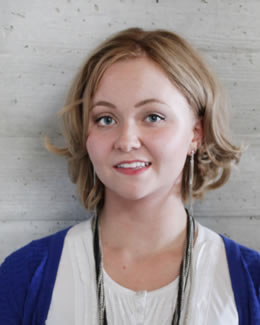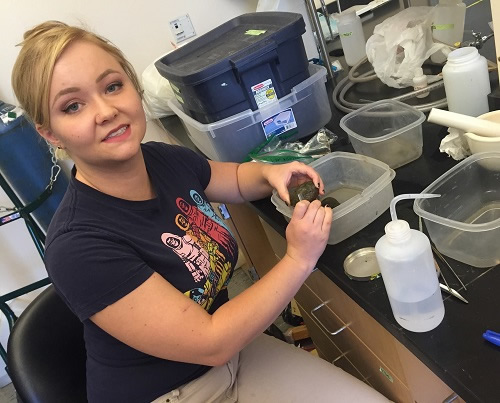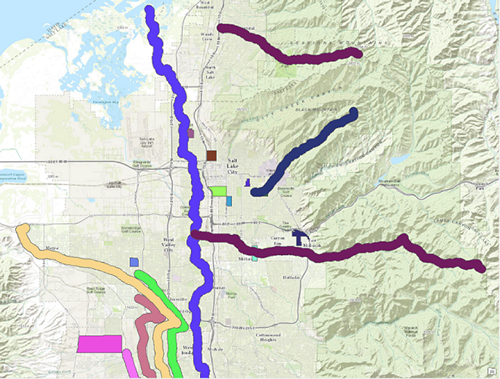iUTAH Team - Undergraduate iFellows

Elizabeth Tanner
Salt Lake Community College
Mentors:
Faculty: Martin Buchert, USU
Graduate: Phillip Stoker, USU
Research Focus:
Research Focus Area 2
Major:
Geology
Biography:
Liz Tanner is an environmental geology student at Salt Lake Community College, where she also works as a geology tutor and lab technician. Her favorite hobby is volunteering at the Natural History Museum of Utah where she prepares fossils in the paleontology lab. Liz is very passionate about sustainability and spreading awareness about environmental issues. She is currently president of the Environmental Club at Salt Lake Community College.
Weekly Recap:
Week 1 | Week 2 | Week 3 | Week 4 | Week 5 | Week 6 | Week 7 | Week 8 | Week 9 | Week 10 | Week 11
Week 1: May 18-22, 2015
For the first week of my iUTAH fellowship, I met my advisors Martin Buchert and Philip Stoker and began using ArcGIS and Excel, which I'll be using throughout the summer. We talked about the research that I'll be doing, which I'm very excited about. The research will be examining disproportionate water use throughout Utah and the United States. I'll also be looking at what the water is used for, what type of climate is at the area, and if anything can be done about it. In addition to discussing future research, a few of us observed Red Butte Creek by car and foot, which I had never done before.
Week 2: May 25-29, 2015
During this second week as an iFellow, I have started using new software and have started to doing different projects. Earlier this week I examined the levels of water consumption in Salt Lake City and created a theoretical data chart (Table 1) that explores how much water would be saved if the population of Salt Lake City were to reduce water usage by 10%, 25%, and 50%. I looked at the top 10% of users of water in Salt Lake City and calculated the same scenario. These data were based off of public utility records provided to me. According to the numbers collected, the top 10% of water users in Salt Lake City use 58.6% of the water consumed. This means that if there were incentives for just the top 10% of water users in Salt Lake City to conserve water, there could be very significant changes to total water use.

For the second half of the week, I’ve started doing a larger project that asks if living proximity to riparian corridors (streams and rivers) leads to a difference in residential water conservation and overall attitude towards water issues. Other factors that will be looked at include whether or not the size, water health, public accessibility, and recreational activities that include the stream or river have an effect as well.
Week 3: June 1-5, 2015
During the third week of my iUTAH fellowship I researched different bodies of water that are relevant to a survey that was sent out by a team my mentor, Philip, researched with. With this survey we are hoping to determine whether living near a river or stream affects the way people think about water policy and conservation. If there is a correlation, different variables that will be looked at will include water size, type, and whether or not there are leisure activities available on the water. I’ve spent a lot of time this week trying to come up with a “scenic grade” for these canals and rivers, which I’ve discovered is pretty difficult if you’ve never been to the area!
Week 4: June 8-12, 2015
No Entry
Week 5: June 15-19, 2015
During this past week with iUTAH, we had a cohort meeting at BYU and I was able to do some fieldwork with other iFellows. Matt, Vivianne, Jordan, and I had the task of using GPS to plot access points for some urban riparian corridors through the Salt Lake area. It was a nice break from writing and I was able to see some places I’ve never visited despite living in Salt Lake City for four years. I’ve been writing about these URC for a while, and actually visiting them will make future writing much easier.

Photo Left: Parley's Creek within Parley's Historic Nature Park
Photo Right: Shift water from Red Butte Creek
Week 6: June 22-26, 2015
For week 6, I spent most of my time doing fieldwork in Logan, which was a change from what I've been doing. I started out recording river and stream discharge data but ended up helping collect mayflies for most of the week. The days were very long and hot but it was a lot of fun to spend some time outside. I also created a poster for a cohort meeting that I think went reasonably well.
Week 7: June 29-July 3, 2015
For week 7 as an iFellow, I attended a meeting with other iFellows where we all presented posters with the data that we have so far concerning our research projects. My research project is examining whether there is a relationship between living proximity to urban riparian corridors and attitudes about water conservation and policy. If there is a relationship, I'll be attempting to determine if characteristics (both qualitative and quantitative) have any effect on the residents. My presentation went well and I was glad to learn that I'm not the only one still analyzing data!
Week 8: July 6-10, 2015
For week 8, I spent a lot of time fiddling with GIS trying to find a good way to quantify the amount of vegetation in selected areas. My mentor, Martin, has been hugely helpful when it comes to this software. I’ve now created a nice base map with all of the urban riparian corridors (URC) that I’m observing that will be helpful during my next weeks with iUTAH.
Week 9: July 13-17, 2015
This week as an iFellow, I spent some time moving our office stuff because our original office is under construction. I also spent time preparing my poster for the symposium. The symposium was a great opportunity for meeting people in the iUTAH community. It was very beneficial to talk to people about the research I've been doing for pointers.
Week 10: July 20-24, 2015
For week 10 of the iFellows program, I spent most of my time performing field and lab work concerning Red Butte Creek. I was helping a lab technician, Simone Jackson, with a research project she is doing that is concerned with food webs in streams. We collected mayflies, stoneflies, free-swimming caddis flies, algae, and leaves to get an idea of what organisms are eating. After collection, we measured and counted the flies. The samples will soon have their isotopes analyzed to see if there is any major difference among areas. This week was a lot of fun and we saw a lot of wildlife, including a mountain lion.

Scraping algae off of rocks
Week 11: July 27-31, 2015
For my last week as an iFellow, I prepared a presentation for our final iFellow Symposium. The Symposium was a lot of fun and I really enjoyed seeing everyone present. I'm sad to be done with the program but am excited about continuing my research beyond my time here.



